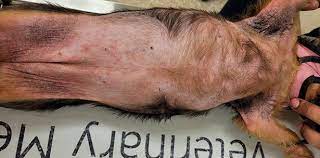
KIT CURRENTLY ON SALE R1850 - do check our website for details.
Approximately 10 percent of dogs affected by atopic dermatitis, and it is believed to be the most prevalent skin disease in dogs, with about 60 breeds, considered predisposed. Dogs typically are affected around 1 to 3 years of age, and it is important to determine the allergens causing the condition, and very often it is not just one allergen causing the problem, but many. Our allergy test is the only allergy test available that will measure the proteins found in your dog’s spittle and report on 100+ items that may be affecting your dog. Easy to do and in the comfort of your own home. www.muttmix.co.za.
Approximately 10 percent of dogs affected by atopic dermatitis, and it is believed to be the most prevalent skin disease in dogs, with about 60 breeds, considered predisposed. Dogs typically are affected around 1 to 3 years of age, and it is important to determine the allergens causing the condition, and very often it is not just one allergen causing the problem, but many. Our allergy test is the only allergy test available that will measure the proteins found in your dog’s spittle and report on 100+ items that may be affecting your dog. Easy to do and in the comfort of your own home. www.muttmix.co.za.
Hyposensitizing Dogs to Atopic Dermatitis
|
Cracking the code to successfully manage the environmental allergens that ailed “Henry,” a gentle, loving chocolate Labrador Retriever, turned into a strategic operation against a plethora of pollens, moulds, dust mites, and dander to which he was sensitized.
Frequent itchy spells starting when Henry was around 1 year of age caused him to scratch and lick incessantly, making his ears, belly, underarms, and groin area fire-engine red and often wet. Scabs dotted the exterior corners of his eyes, which were commonly void of brows and lashes due to his rubbing. His coat turned thin and patchy, with streaks of scabs running down his back and legs.
Blood allergy testing showed that Henry was allergic to virtually all 43 allergens on the test. He began allergen-specific immunotherapy (ASIT) consisting of “vaccine” injections made from the allergens to which he tested positive. Antifungals and antibiotics were prescribed for the yeast and bacterial infections present in Henry’s ears and sores, and a steroid was given to curb the itchiness, though it made him thirsty and hungry.
As the male retriever turned 2 years old, having cycled through spring and fall allergy seasons and treatments that offered only temporary relief, Henry’s primary veterinarian referred owners Janice and Kevin Butler of Phenix City, Alabama, to a specialist at Auburn University. Robert Kennis, DVM, MS, DACVD, professor of veterinary dermatology, began a tactical approach to dealing with Henry’s atopic dermatitis that centered on keeping him as clean as possible via frequent bathing combined with ASIT and supportive medications and supplements.
Henry is among 10 percent of dogs affected by atopic dermatitis, a chronic inflammatory skin disease caused by an inappropriate immune reaction to environmental allergens that are mainly absorbed through the skin, orally or from breathing. Affected dogs lack skin barrier protection against allergens, which allows them to penetrate the skin and trigger allergies. It is believed to be the most prevalent skin disease in dogs, with about 60 breeds, including Labrador Retrievers, considered predisposed. A lifelong disease, atopic dermatitis is, at best, managed but never cured.
“Atopic dermatitis is a multifactorial genetically predisposed disease of variable expression in which exposure to allergens affects a dog’s sensitization,” explains Dr. Kennis. “Allergy shots (ASIT) help about 75 percent of dogs, but these dogs may need additional therapy during allergy season and may still get periodic infections. Regardless, allergy shots are much better than long-term use of steroids or other drugs that suppress the immune system.”“I began keeping a journal of Henry’s itching,” Janice Butler says. “By recording his allergy behavior, it helped me to be aware of when we were having a low- or high-allergy day and adjust the vaccine serum accordingly. It has been a process of trial and error to find out what works best for Henry. What really made the difference is keeping him clean.”
Seven years into treatment, Henry is healthy and handsome, and his coat is thick and shiny. Most people who meet him have no idea of his allergy regimen. He is bathed on Wednesdays and Saturdays with a medicated shampoo and then sprayed with a bacterial and fungal preventive. He also is sprayed regularly with a soothing solution that restores natural oils to his coat. Besides twice weekly allergy shots, Henry takes allergy relief pills (antihistamines) as needed and an omega-3 fatty acid supplement.
The Butlers spend about $300 a month caring for Henry. “I sometimes wonder what would have happened to Henry if he didn’t have owners like us,” says Janice Butler. “Giving up on him was never an option. We are very lucky to have Dr. Kennis. We don’t see the flare-ups now like we did, thanks to him.”
A COMPLEX DISEASE TO DIAGNOSE
The second most common allergy in dogs after flea bite allergy, atopic dermatitis can be challenging to diagnose partly because the clinical signs of scratching, rubbing, chewing, and excessive grooming overlap with signs of other allergies. Adding to the complexity of diagnosing the disease, dogs can have concurrent allergies. Henry, the Labrador Retriever, for example, tested positive for flea bite allergy, one of the 43 allergens to which he was hypersensitive.
Dogs typically are affected around 1 to 3 years of age. Allergies occur when allergens trigger an inappropriate immune response resulting in the production of allergen-specific IgE (immunoglobulin E) antibodies.
“These immuno globulins bind to mast cells and then become cross-linked by specific allergens, leading to mast-cell degranulation and the development of urticaria, a type I hypersensitivity reaction,” Dr. Kennis says. “When this occurs, many cytokines are upregulated, causing pruritus (itching) and inflammation.”
Allergy testing can be performed to help detect a dog’s allergies once a veterinarian confirms a diagnosis of atopic dermatitis. Intradermal testing (IDT) in which small injections of allergens are made into the skin on one side of a dog’s body where the coat is shaved is considered the gold standard. An alternative method, allergen-specific IgE serology (ASIS), or blood allergy testing, has advantages over IDT because no sedation is required, it is less traumatic without repeated injections, and there is less risk of interference from anti-inflammatory or antipruritic medications that a dog may already be taking. Both types of allergy testing ultimately produce information to formulate ASIT, or allergy shots, to reduce clinical signs.
There are many ambiguities related to understanding the genetics and clinical features of atopic dermatitis. To learn more about this skin disease, the AKC Canine Health Foundation is funding research. A study recently completed at Texas A&M University focused on better understanding the skin microbiome of normal and atopic dogs. Meanwhile, a soon-to-be completed study at the University of Florida is examining how to boost the body’s natural antimicrobial defenses against allergens.
“Canine atopic dermatitis is a chronic disease that is expensive to treat and challenging for both dog owners and veterinarians,” says Diane E. Brown, DVM, PhD, DACVP, Chief Executive Officer of the Canine Health Foundation. “The AKC Canine Health Foundation is committed to funding research to improve understanding of the pathophysiology, environmental triggers and exacerbating factors that contribute to this disease in an effort to improve outcomes for dogs that suffer from this condition.”
INVESTIGATING ATOPIC DERMATITIS
Imagine being able to build a better skin barrier to help protect dogs against allergens that cause allergies. Aline Rodrigues Hoffmann, DVM, PhD, DACVP, assistant professor of veterinary pathology at Texas A&M University, believes it is possible. She is an investigator of a study that used bacterial and fungal DNA sequencing to describe the natural bacterial and fungal microbiome of canine skin and to identify changes that occur in allergic dogs.
“We have found that allergic skin disease results in lower diversity of the microbiome possibly because the skin of allergic dogs becomes more permissive to the proliferation of certain bacterial and fungal groups,” Dr. Rodrigues Hoffmann says. “This skin barrier dysfunction is important for the pathogenesis of canine atopic dermatitis.”
Dr. Rodrigues Hoffmann hopes to better understand how multiple factors, such as age, sex, breed, and environment, can influence the microbiome of healthy dogs and dogs with atopic dermatitis. “We are just beginning to learn about the skin microbiome in animals,” she says. “We also want to identify the good bacteria and perhaps develop probiotics that could compete with pathogenic bacteria to reduce the use of antimicrobial treatment.”
As in humans with allergies, atopic dogs have altered skin barrier function, transepidermal water loss and decreased ceramide concentrations, and some dogs are believed to have abnormal fillagrin expression. Domenico Santoro, DVM, MS, DrSc, PhD, DACVD, DECVD, assistant professor of veterinary dermatology at the University of Florida, explains, “Fillagrin is a protein associated with filaments that bind to keratin fibers in epithelial cells. It is essential for skin barrier function, and in people fillagrin mutations are associated with a subtype of atopic dermatitis. Ceramides are important because they allow the stratum corneum layer of the skin to stretch and bend by fluidizing the lipid barrier on the surface. Defects in ceramide can result in poor barrier function.”
In his current study, Dr. Santoro aims to discover a revolutionary treatment for atopic dermatitis by looking at antimicrobial peptides (AMPs), small proteins that defend against pathogens. “We want to know if allergic dogs, like people, have lower AMP secretion,” he says.
“Our hypothesis is that defective secretion of AMPs by allergic skin cells is associated with reduced microbicidal effects by atopic keratinocytes,” says Dr. Santoro. “Keratinocytes are highly active immunological cells involved in the acute and chronic phases of skin inflammation via production of chemokines and expression of surface molecules. Keratinocytes from genetic skin disorders like atopic dermatitis may show intrinsic abnormalities in their capacity to respond to trigger factors. This results in bacteria not being effectively killed due to the retention of a higher amount of AMPs by allergic skin cells. Ultimately, this could cause the recurrent infections associated with atopic dermatitis.”
The abnormal immunological response of atopic dogs to common allergens could be due to a defect in the skin barrier or it could be the allergic response itself induces the skin abnormality, Dr. Santoro says. “Because allergies are so common in dogs and frequently are associated with recurrent, antibiotic-resistant skin infections, it is important to identify ways to boost the ability to help dogs fight infection,” he says.
STAYING ON TOP OF ALLERGIES
Atopic dermatitis is a life-changing disease for dogs and the owners who love them. It requires diligence from owners to monitor their dog’s allergic responses and to work closely with their veterinarian to help keep them comfortable.
Janice Butler has come a long way with 8-year-old Henry. “Even simple things changed for us,” she says. “Henry can never just jump in a lake to retrieve a bumper or toy because lakes are filled with pollen. He can only swim in clean swimming pools. Despite all we’ve been through, Henry is the perfect dog for us.”
Veterinary experts caution breeders not to breed dogs diagnosed with atopic dermatitis due to the genetic inheritance of the disease. “These dogs should not be bred, especially in cases where the sire and dam are severely affected,” Dr. Santoro says.
The good news is that studies such as the skin microbiome work of Dr. Rodrigues Hoffmann and the antimicrobial peptide investigation of Dr. Santoro may soon lead to new treatments that may help the nearly 8 million dogs in the country that suffer from environmental allergies. In the meantime, watching out for an atopic dog’s response to seasonal allergies should become second nature to owners.
BREEDS PREDISPOSED TO ATOPIC DERMATITIS
Breeds considered prone to developing atopic dermatitis include the following, though this listing is not all-inclusive.
Basset Hound
Bichon Frise
Boston Terrier
Boxer
Bull Terrier
Bulldog
Chinese Shar-Pei
Cocker Spaniel
Dalmatian
English Setter
English Springer Spaniel
French Bulldog
Golden Retriever
Hungarian Vizsla
Irish Setter
Labrador Retriever
Lhasa Apso
Maltese
Pug
Rhodesian Ridgeback
Shih Tzu
Terriers (All)
Tibetan Terrier
TIPS ON CARING FOR A DOG WITH ATOPIC DERMATITIS
1. Never allow dogs with atopic dermatitis to stick their head out a window of a moving vehicle. This exposes them to pollens that can be absorbed through the skin or inhaled.
2. Antihistamines can be helpful in reducing clinical signs of atopic dermatitis, but some antihistamines have a sedating effect and thus could affect a dog’s performance. Consult your veterinarian to find an appropriate antihistamine for your individual dog.
3. Wipe off a dog’s feet when they come in from outdoors to help reduce pollen in between their paw pads. This is particularly important in dogs that frequently lick their feet.
4. Bathing dogs after swimming or working in the field may help reduce allergens on their coats.
Frequent itchy spells starting when Henry was around 1 year of age caused him to scratch and lick incessantly, making his ears, belly, underarms, and groin area fire-engine red and often wet. Scabs dotted the exterior corners of his eyes, which were commonly void of brows and lashes due to his rubbing. His coat turned thin and patchy, with streaks of scabs running down his back and legs.
Blood allergy testing showed that Henry was allergic to virtually all 43 allergens on the test. He began allergen-specific immunotherapy (ASIT) consisting of “vaccine” injections made from the allergens to which he tested positive. Antifungals and antibiotics were prescribed for the yeast and bacterial infections present in Henry’s ears and sores, and a steroid was given to curb the itchiness, though it made him thirsty and hungry.
As the male retriever turned 2 years old, having cycled through spring and fall allergy seasons and treatments that offered only temporary relief, Henry’s primary veterinarian referred owners Janice and Kevin Butler of Phenix City, Alabama, to a specialist at Auburn University. Robert Kennis, DVM, MS, DACVD, professor of veterinary dermatology, began a tactical approach to dealing with Henry’s atopic dermatitis that centered on keeping him as clean as possible via frequent bathing combined with ASIT and supportive medications and supplements.
Henry is among 10 percent of dogs affected by atopic dermatitis, a chronic inflammatory skin disease caused by an inappropriate immune reaction to environmental allergens that are mainly absorbed through the skin, orally or from breathing. Affected dogs lack skin barrier protection against allergens, which allows them to penetrate the skin and trigger allergies. It is believed to be the most prevalent skin disease in dogs, with about 60 breeds, including Labrador Retrievers, considered predisposed. A lifelong disease, atopic dermatitis is, at best, managed but never cured.
“Atopic dermatitis is a multifactorial genetically predisposed disease of variable expression in which exposure to allergens affects a dog’s sensitization,” explains Dr. Kennis. “Allergy shots (ASIT) help about 75 percent of dogs, but these dogs may need additional therapy during allergy season and may still get periodic infections. Regardless, allergy shots are much better than long-term use of steroids or other drugs that suppress the immune system.”“I began keeping a journal of Henry’s itching,” Janice Butler says. “By recording his allergy behavior, it helped me to be aware of when we were having a low- or high-allergy day and adjust the vaccine serum accordingly. It has been a process of trial and error to find out what works best for Henry. What really made the difference is keeping him clean.”
Seven years into treatment, Henry is healthy and handsome, and his coat is thick and shiny. Most people who meet him have no idea of his allergy regimen. He is bathed on Wednesdays and Saturdays with a medicated shampoo and then sprayed with a bacterial and fungal preventive. He also is sprayed regularly with a soothing solution that restores natural oils to his coat. Besides twice weekly allergy shots, Henry takes allergy relief pills (antihistamines) as needed and an omega-3 fatty acid supplement.
The Butlers spend about $300 a month caring for Henry. “I sometimes wonder what would have happened to Henry if he didn’t have owners like us,” says Janice Butler. “Giving up on him was never an option. We are very lucky to have Dr. Kennis. We don’t see the flare-ups now like we did, thanks to him.”
A COMPLEX DISEASE TO DIAGNOSE
The second most common allergy in dogs after flea bite allergy, atopic dermatitis can be challenging to diagnose partly because the clinical signs of scratching, rubbing, chewing, and excessive grooming overlap with signs of other allergies. Adding to the complexity of diagnosing the disease, dogs can have concurrent allergies. Henry, the Labrador Retriever, for example, tested positive for flea bite allergy, one of the 43 allergens to which he was hypersensitive.
Dogs typically are affected around 1 to 3 years of age. Allergies occur when allergens trigger an inappropriate immune response resulting in the production of allergen-specific IgE (immunoglobulin E) antibodies.
“These immuno globulins bind to mast cells and then become cross-linked by specific allergens, leading to mast-cell degranulation and the development of urticaria, a type I hypersensitivity reaction,” Dr. Kennis says. “When this occurs, many cytokines are upregulated, causing pruritus (itching) and inflammation.”
Allergy testing can be performed to help detect a dog’s allergies once a veterinarian confirms a diagnosis of atopic dermatitis. Intradermal testing (IDT) in which small injections of allergens are made into the skin on one side of a dog’s body where the coat is shaved is considered the gold standard. An alternative method, allergen-specific IgE serology (ASIS), or blood allergy testing, has advantages over IDT because no sedation is required, it is less traumatic without repeated injections, and there is less risk of interference from anti-inflammatory or antipruritic medications that a dog may already be taking. Both types of allergy testing ultimately produce information to formulate ASIT, or allergy shots, to reduce clinical signs.
There are many ambiguities related to understanding the genetics and clinical features of atopic dermatitis. To learn more about this skin disease, the AKC Canine Health Foundation is funding research. A study recently completed at Texas A&M University focused on better understanding the skin microbiome of normal and atopic dogs. Meanwhile, a soon-to-be completed study at the University of Florida is examining how to boost the body’s natural antimicrobial defenses against allergens.
“Canine atopic dermatitis is a chronic disease that is expensive to treat and challenging for both dog owners and veterinarians,” says Diane E. Brown, DVM, PhD, DACVP, Chief Executive Officer of the Canine Health Foundation. “The AKC Canine Health Foundation is committed to funding research to improve understanding of the pathophysiology, environmental triggers and exacerbating factors that contribute to this disease in an effort to improve outcomes for dogs that suffer from this condition.”
INVESTIGATING ATOPIC DERMATITIS
Imagine being able to build a better skin barrier to help protect dogs against allergens that cause allergies. Aline Rodrigues Hoffmann, DVM, PhD, DACVP, assistant professor of veterinary pathology at Texas A&M University, believes it is possible. She is an investigator of a study that used bacterial and fungal DNA sequencing to describe the natural bacterial and fungal microbiome of canine skin and to identify changes that occur in allergic dogs.
“We have found that allergic skin disease results in lower diversity of the microbiome possibly because the skin of allergic dogs becomes more permissive to the proliferation of certain bacterial and fungal groups,” Dr. Rodrigues Hoffmann says. “This skin barrier dysfunction is important for the pathogenesis of canine atopic dermatitis.”
Dr. Rodrigues Hoffmann hopes to better understand how multiple factors, such as age, sex, breed, and environment, can influence the microbiome of healthy dogs and dogs with atopic dermatitis. “We are just beginning to learn about the skin microbiome in animals,” she says. “We also want to identify the good bacteria and perhaps develop probiotics that could compete with pathogenic bacteria to reduce the use of antimicrobial treatment.”
As in humans with allergies, atopic dogs have altered skin barrier function, transepidermal water loss and decreased ceramide concentrations, and some dogs are believed to have abnormal fillagrin expression. Domenico Santoro, DVM, MS, DrSc, PhD, DACVD, DECVD, assistant professor of veterinary dermatology at the University of Florida, explains, “Fillagrin is a protein associated with filaments that bind to keratin fibers in epithelial cells. It is essential for skin barrier function, and in people fillagrin mutations are associated with a subtype of atopic dermatitis. Ceramides are important because they allow the stratum corneum layer of the skin to stretch and bend by fluidizing the lipid barrier on the surface. Defects in ceramide can result in poor barrier function.”
In his current study, Dr. Santoro aims to discover a revolutionary treatment for atopic dermatitis by looking at antimicrobial peptides (AMPs), small proteins that defend against pathogens. “We want to know if allergic dogs, like people, have lower AMP secretion,” he says.
“Our hypothesis is that defective secretion of AMPs by allergic skin cells is associated with reduced microbicidal effects by atopic keratinocytes,” says Dr. Santoro. “Keratinocytes are highly active immunological cells involved in the acute and chronic phases of skin inflammation via production of chemokines and expression of surface molecules. Keratinocytes from genetic skin disorders like atopic dermatitis may show intrinsic abnormalities in their capacity to respond to trigger factors. This results in bacteria not being effectively killed due to the retention of a higher amount of AMPs by allergic skin cells. Ultimately, this could cause the recurrent infections associated with atopic dermatitis.”
The abnormal immunological response of atopic dogs to common allergens could be due to a defect in the skin barrier or it could be the allergic response itself induces the skin abnormality, Dr. Santoro says. “Because allergies are so common in dogs and frequently are associated with recurrent, antibiotic-resistant skin infections, it is important to identify ways to boost the ability to help dogs fight infection,” he says.
STAYING ON TOP OF ALLERGIES
Atopic dermatitis is a life-changing disease for dogs and the owners who love them. It requires diligence from owners to monitor their dog’s allergic responses and to work closely with their veterinarian to help keep them comfortable.
Janice Butler has come a long way with 8-year-old Henry. “Even simple things changed for us,” she says. “Henry can never just jump in a lake to retrieve a bumper or toy because lakes are filled with pollen. He can only swim in clean swimming pools. Despite all we’ve been through, Henry is the perfect dog for us.”
Veterinary experts caution breeders not to breed dogs diagnosed with atopic dermatitis due to the genetic inheritance of the disease. “These dogs should not be bred, especially in cases where the sire and dam are severely affected,” Dr. Santoro says.
The good news is that studies such as the skin microbiome work of Dr. Rodrigues Hoffmann and the antimicrobial peptide investigation of Dr. Santoro may soon lead to new treatments that may help the nearly 8 million dogs in the country that suffer from environmental allergies. In the meantime, watching out for an atopic dog’s response to seasonal allergies should become second nature to owners.
BREEDS PREDISPOSED TO ATOPIC DERMATITIS
Breeds considered prone to developing atopic dermatitis include the following, though this listing is not all-inclusive.
Basset Hound
Bichon Frise
Boston Terrier
Boxer
Bull Terrier
Bulldog
Chinese Shar-Pei
Cocker Spaniel
Dalmatian
English Setter
English Springer Spaniel
French Bulldog
Golden Retriever
Hungarian Vizsla
Irish Setter
Labrador Retriever
Lhasa Apso
Maltese
Pug
Rhodesian Ridgeback
Shih Tzu
Terriers (All)
Tibetan Terrier
TIPS ON CARING FOR A DOG WITH ATOPIC DERMATITIS
1. Never allow dogs with atopic dermatitis to stick their head out a window of a moving vehicle. This exposes them to pollens that can be absorbed through the skin or inhaled.
2. Antihistamines can be helpful in reducing clinical signs of atopic dermatitis, but some antihistamines have a sedating effect and thus could affect a dog’s performance. Consult your veterinarian to find an appropriate antihistamine for your individual dog.
3. Wipe off a dog’s feet when they come in from outdoors to help reduce pollen in between their paw pads. This is particularly important in dogs that frequently lick their feet.
4. Bathing dogs after swimming or working in the field may help reduce allergens on their coats.





